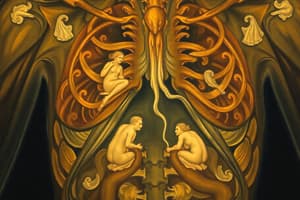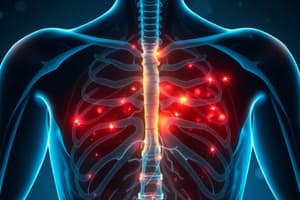Podcast
Questions and Answers
What percentage of calcium in the body is found in bones and teeth?
What percentage of calcium in the body is found in bones and teeth?
- 100%
- 75%
- 99% (correct)
- 50%
Low albumin levels can cause low overall calcium concentrations while maintaining normal ionized calcium levels.
Low albumin levels can cause low overall calcium concentrations while maintaining normal ionized calcium levels.
True (A)
What is the formula used to correct calcium levels in patients with hypocalcemia and low serum albumin levels?
What is the formula used to correct calcium levels in patients with hypocalcemia and low serum albumin levels?
Corrected calcium (mg/dl) = total calcium (mg/dl) + 0.8 (4 – serum albumin (g/dl))
Calcium exists in plasma in three forms: 50% free (ionized), 40% bound to protein, and ___% bound to anions.
Calcium exists in plasma in three forms: 50% free (ionized), 40% bound to protein, and ___% bound to anions.
Which of the following conditions can cause hypocalcemia?
Which of the following conditions can cause hypocalcemia?
Match the condition with its corresponding effect on calcium levels:
Match the condition with its corresponding effect on calcium levels:
Patients with renal failure typically experience hypercalcemia.
Patients with renal failure typically experience hypercalcemia.
What type of specimen is preferred for total calcium determinations?
What type of specimen is preferred for total calcium determinations?
Flashcards are hidden until you start studying
Study Notes
Calcium
- A healthy person's body contains approximately 1-1.3 kg of calcium.
- 99% of calcium is found in bones and teeth, 1% in soft tissues, and 0.1% in extracellular space.
- Calcium exists in plasma in three forms: 50% free (ionized), 40% bound to protein, and 10% bound to anions.
- The free form of calcium is biologically active.
Factors Affecting Calcium Concentration
- Albumin concentration:
- Low albumin levels (hypoalbuminemia) can lead to lower overall calcium concentrations, but the ionized, biologically active fraction is usually normal.
- This is a relatively common cause of hypocalcemia in patients without clinical symptoms.
- Corrected calcium can be calculated using the formula: Corrected calcium (mg/dl) = total calcium (mg/dl) + 0.8 (4 – serum albumin (g/dl)).
- pH:
- Acidosis reduces the calcium bond to albumin and increases the ionized calcium fraction.
- Alkalosis reduces the ionized calcium fraction and can lead to symptoms related to hypocalcemia.
Clinical Significance
- Hypercalcemia:
- May be caused by primary hyperparathyroidism, other endocrine disorders (hypothyroidism and acute adrenal insufficiency), malignancy involving bone, and renal failure.
- Hypocalcemia:
- May be caused by hypoparathyroidism, hypoalbuminemia, chronic renal failure, magnesium deficiency, and vitamin D deficiency.
Sample Type and Precautions
- Total Calcium (Ca2+):
- Serum or lithium heparin plasma collected without venous stasis is preferred.
- Avoid using anticoagulants like EDTA or oxalate as they bind Ca2+ tightly and interfere with measurement.
- Ionized Calcium:
- Samples must be collected anaerobically to prevent loss of CO2, which would increase pH and affect the results.
Studying That Suits You
Use AI to generate personalized quizzes and flashcards to suit your learning preferences.



